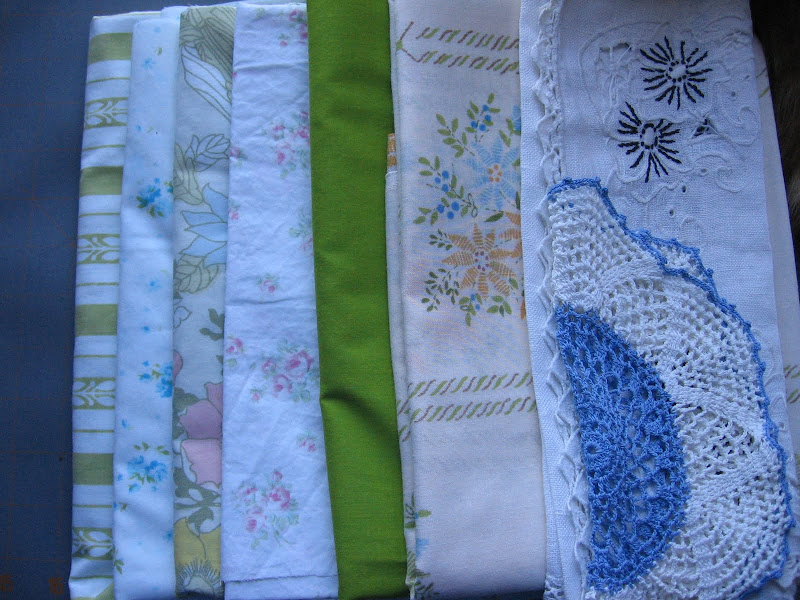Finding something with potential, dragging it home, and making it close to perfect can be an art form. I keep practicing it, anyway, and someday I’ll be a master.
 I bought this turtleneck sweater at the thrift store because I like the color, and because it’s 50% wool. However, I find it increasingly hard to wear things that are tight around the neck. I think it may be an age thing, but this clearly wasn’t going to work. I put the sweater aside, thinking I’d put it into the donation pile, but then I started to see some possibilities in the sweater I hadn’t considered at first. I decided to convert it into a cardigan.
I bought this turtleneck sweater at the thrift store because I like the color, and because it’s 50% wool. However, I find it increasingly hard to wear things that are tight around the neck. I think it may be an age thing, but this clearly wasn’t going to work. I put the sweater aside, thinking I’d put it into the donation pile, but then I started to see some possibilities in the sweater I hadn’t considered at first. I decided to convert it into a cardigan.
The first step may be the scariest, but fear not, you are the master of your project, and if you're like me, and only paid $3 for your sweater, you can be bold with it. Mark the center line of your sweater with chalk or with a sliver of soap. If you're feeling really rebellious, make it an off-center line. Machine stitch along both sides of the line with a narrow zig zag, then cut between the stitched lined with a sharp scissors.
 Make some continuous fabric bias tape. Here is a handy tutorial if you've never done this. In my mind, the fabric you choose can really make your project stand out. I had a fat quarter of this nice pink and brown floral that was perfect. I made 2" wide binding, and it made about double the amount of bias binding I needed for this sweater. You can make your binding wider or narrower, as you like.
Make some continuous fabric bias tape. Here is a handy tutorial if you've never done this. In my mind, the fabric you choose can really make your project stand out. I had a fat quarter of this nice pink and brown floral that was perfect. I made 2" wide binding, and it made about double the amount of bias binding I needed for this sweater. You can make your binding wider or narrower, as you like. Iron your binding in half length-wise just so you have a reference point. Match raw edges of your binding and the wrong side of one half of your sweater, and sew with a straight stitch. I used a 1/4" seam.
Iron your binding in half length-wise just so you have a reference point. Match raw edges of your binding and the wrong side of one half of your sweater, and sew with a straight stitch. I used a 1/4" seam. Flip to the right side, and fold the corners neatly, especially at the neck edge, since the inside edge is going to show. Fold the free edge up to the center crease.
Flip to the right side, and fold the corners neatly, especially at the neck edge, since the inside edge is going to show. Fold the free edge up to the center crease. Fold the binding to the right side so that the sweater edge is completely encased by the binding. Top stitch on the right side. You can see that the binding is wider on the right side than the wrong side. Carefully press the stitched binding so the fold line is no longer visible. If you want it to be even on both sides, use a wider seam allowance when you first attach the binding. Repeat for the other edge of the sweater opening.
Fold the binding to the right side so that the sweater edge is completely encased by the binding. Top stitch on the right side. You can see that the binding is wider on the right side than the wrong side. Carefully press the stitched binding so the fold line is no longer visible. If you want it to be even on both sides, use a wider seam allowance when you first attach the binding. Repeat for the other edge of the sweater opening. I added hooks and eyes to the inside of the sweater opening, and these three vintage buttons are purely for decoration.
I added hooks and eyes to the inside of the sweater opening, and these three vintage buttons are purely for decoration.
I've worn this sweater a few times already. I feel very chic, and clever to boot.
If you want more ideas: Craftzine has a great tutorial for cardiganizing a pullover in which you crochet a new buttonband.
Wardrobe Refashion is a blog that has a constant stream of re-fashioning ideas.
Sister Diane at Craftypod has done an excellent series of podcasts on the concept of "Free" in the on-line crafting community. She also has a great list of links to related discussions. Check out her earlier podcast and show notes as well, where she describes her own experience providing free craft content on the web.




















